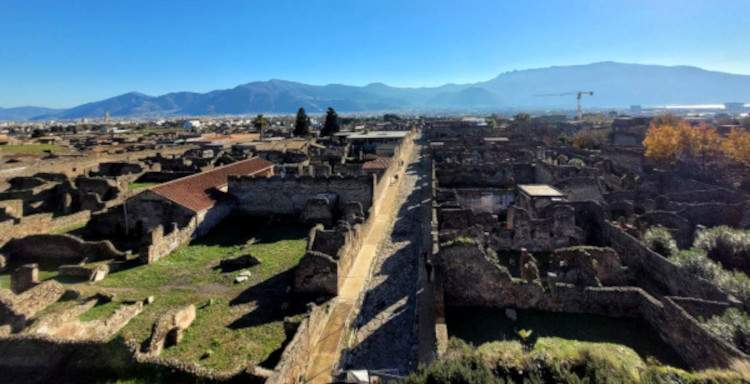Pompeii, the Tower of Mercury, the highest point from which to view the ancient city, is accessible
By climbing the Tower of Mercury, one of Pompeii’s most intact watchtowers, it is possible to get a glimpse of the entire northwestern sector of the ancient city from its highest point. As of Dec. 23, in fact, it has been possible to enter the tower in limited groups. Watchtowers were inserted in the early first century B.C. into the city walls to improve the control of the city, and from the Mercury Tower one can understand the strategic position between Vesuvius, the sea and the Sarno Valley.
The structure is on three levels, including the ground floor. It has been the subject of a recent restoration and enhancement project that is affecting the entire northern sector of Pompeii’s fortifications, after which it will then also be possible to visit the upper section that joined the Mercury tower with the next one. The blocks in particular of the masonry, consisting of different materials, stone and tuffaceous, required major safety and conservation work.
Two essays already conducted in 1927-29 by Amedeo Maiuri were also reopened in this area in order to probe the earliest phases of the city’s fortification and its urban layout. Of particular interest are the traces of the furrows of war machines used for defense during Sulla’s attack in 89 B.C., which emerged along the patrol walkway.
“Archaeological investigations, coordinated by Professor Marco Fabbri of Tor Vergata University,” explains Pompeii Archaeological Park director Gabriel Zuchtriegel, “have shown that where the tower now stands, there was a city gate until the 4th century BC, which was then obliterated. This is a finding that opens up exciting perspectives not only on the urban layout of the oldest Pompeii, but also on the space outside the walls. It would be interesting to understand where this road led and whether on its sides, as was the custom in ancient times, there were tombs from those periods.”
As early as the 6th century BC. Pompeii was provided with a fortification, which was strengthened and supplemented several times over time until the 1st century BC. However, they did not always succeed in providing protection, as happened during Sulla’s siege that led to the capture of the city and its reduction to a Roman colony. It is precisely in this stretch of wall between Herculaneum Gate and Vesuvius Gate that the marks of bullets launched from the catapults of Sulla’s army are visible.
On this occasion, numerous reconstructions of the outer curtain, damaged in previous historical events, were carried out and, above all, a series of watchtowers, placed at more or less regular intervals, straddling the curtain, were added to the circuit of the fortifications. As Rome’s authority consolidated and external dangers diminished, the defensive function of the fortifications declined in importance and the walls acquired a monumental and symbolic, urbanistic rather than strategic value.
 |
| Pompeii, the Tower of Mercury, the highest point from which to view the ancient city, is accessible |
Warning: the translation into English of the original Italian article was created using automatic tools. We undertake to review all articles, but we do not guarantee the total absence of inaccuracies in the translation due to the program. You can find the original by clicking on the ITA button. If you find any mistake,please contact us.




























